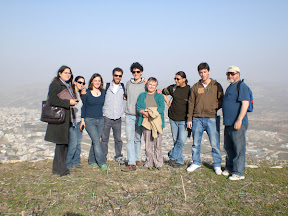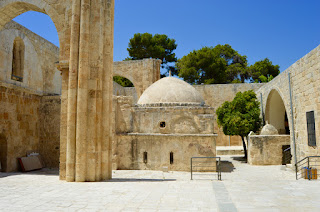
includes accommodation, daily tours, most meals
Monday 12 – Sunday 18 October, 2020
- Visit 5 cities
- Help Palestinian farmers
- Learn about cultural and agricultural importance of olives
- Tour the West Bank
- Learn about life under Occupation
- Palestinian society
- Meet local people
The annual olive harvest has been an important cultural, economic and symbolic event in Palestine for thousands of years. It usually only takes a few weeks from beginning to end but it is very labour intensive and extra hands are always welcome.
On this unique tour, we will give you the opportunity to take part in the harvest, learn about Palestinian culture and work with farmers on the land.
You’ll spend some time volunteering and will also be able to tour Jerusalem and visit the West Bank’s most important cities; Bethlehem, Hebron, Ramallah and Nablus.
You’ll stay with families in Beit Sahour (near Bethlehem) and in the guesthouse at Sebastiya (near Nablus), close to where you will be working. This will allow you to form relationships with your hosts and learn about their daily lives.
You’ll see four Palestinian cities, meet dozens of Palestinians, be immersed in the life of a village under Occupation, and be provided with a huge amount of information about Palestinian history, culture and the current political situation.
Day 1 – Monday 12 October – Greater Jerusalem and the Old City
 9.00am. You will meet the group at the Jerusalem Hotel Cafe. Your trip will start with a briefing with maps and an alternative tour of Jerusalem’s old city, taking in the Western Wall and views of the Dome of the Rock in addition to seeing the Israeli settler homes that have been sprouting in the Muslim Quarter.
9.00am. You will meet the group at the Jerusalem Hotel Cafe. Your trip will start with a briefing with maps and an alternative tour of Jerusalem’s old city, taking in the Western Wall and views of the Dome of the Rock in addition to seeing the Israeli settler homes that have been sprouting in the Muslim Quarter.
You’ll learn about the symbolic importance of the old city to all people’s of the Middle East and the implications of Israeli encroachment into Arab areas of the Old City.
After lunch you will go on the road for a tour of Greater Jerusalem. On this trip you will learn about the stark differences between the Eastern and Western parts of the city, as well as see segregated roads and expanding Israeli settlements in the heart of Arab East Jerusalem. You’ll also enjoy some of the best views of Jerusalem on this driving tour.
Then off to Beit Sahour to meet your host family after a busy and intense first day.
Day 2 – Tuesday 13 October – Hebron
 After breakfast, you’ll be met by an Israeli guide for the journey south to Hebron. This is the most tragic city in the West Bank as it remains divided into Israeli and Palestinian sides to this day. You will be able to visit the settlement of Kiryat Arba and see the tomb of Baruch Goldstein, a terrorist who massacred 29 people in Hebron in 1994. You will be able to visit both the Jewish and Muslim sides of Abraham’s Tomb and the walk the main road – Shuhada Street – now largely a ghost town only open to the ~400 settlers living in the heart of the city, the army protecting them, and international visitors.
After breakfast, you’ll be met by an Israeli guide for the journey south to Hebron. This is the most tragic city in the West Bank as it remains divided into Israeli and Palestinian sides to this day. You will be able to visit the settlement of Kiryat Arba and see the tomb of Baruch Goldstein, a terrorist who massacred 29 people in Hebron in 1994. You will be able to visit both the Jewish and Muslim sides of Abraham’s Tomb and the walk the main road – Shuhada Street – now largely a ghost town only open to the ~400 settlers living in the heart of the city, the army protecting them, and international visitors.
Lunch today can be in a Palestinian family home, where you will also meet your local Palestinian guide for the second half of the tour. In the afternoon you can walk the streets of the old city which was recently added to UNESCO’s World Heritage list. You’ll also go to a traditional glass blowing workshop that recycles glass from the city, crafting beautiful objects and also makes nice ceramics. This evening your meal and overnight are back with the homestay in Beit Sahour.
Day 3 – Wednesday 14 October – Bethlehem & Ramallah
Today you’ll begin with a drive around the east of Jerusalem through the Judean Desert to Ramallah. You’ll see many Jewish settlements en-route and enter the city through a checkpoint into the neighborhood of Kufr Akab.
Although technically part of the city of Jerusalem, the Separation Wall divides it from the municipality to which the residents pay city taxes. You’ll visit Arafat’s Tomb and walk the streets of this bustling city, now the de-facto Capital for Palestinians in the West Bank.
From there you will head back into Bethlehem. You will begin in Manger Square where the Mosque of Omar and the Church of the Nativity sit on either side. You can enter the church, one of the oldest in the world, built over the site where traditional holds Jesus was born. Next you will visit the Aida Refugee Camp, where you can meet with camp leaders and learn about the work they are doing and the plight of the Palestinian refugee. You will also come up close and personal with the West Bank barrier which surrounds Bethlehem from three sides.
A short walk along the Wall brings you to the Walled Off Hotel, the most dramatic project by renowned British graffiti artist Banksy. As well as a visit to the gallery and lounge bar, you’ll see much of his original work on the wall itself, as well as pieces by other famous artists.
From Bethlehem back to Beit Sahour is just a short trip for dinner and your final night in the homestay.
Day 4 – Thursday 15 October – Samaritans, Balata Refugee Camp and Nablus
You’ll travel up the spine of the West Bank on route 60, seeing many small settlements and Palestinian villages. You will visit the Samaritan village on Mount Gerizim, and learn about its ancient people who have survived despite the odds against them. After descending the mountain, you will visit Balata, the biggest refugee camp in the West Bank, where you’ll see the crowded conditions and hear some stories about life there. You’ll also visit one of the camp organizations that helps make life a little better for the residents. Next to the camp is Jacob’s Well; a ancient, deep well thought to have been dug by Jacob and where Jesus once asked a Samaritan woman for a drink.
Then you will enjoy a walk through the old city of Nablus with its beautiful labyrinth of buildings mostly dating back to the Ottoman period. There are local treats such as knafeh to be tried, and the atmosphere in the suq is always very lively.
After this, you will head to the Daily Hugz Rescued Animal Sanctuary to meet your host Maad. He has rescued dozens of donkeys and dogs and cares for them in his beautiful property. It is surrounded by olive groves, and it is here that you will work. Maad will give you an introductory tour and prepare a home cooked meal. That evening you will check into the guest house in nearby Sebastiya.
Day 5 – Friday 16 October – Sebastiya and the olive harvest festival
This morning you can visit the archeological site of Sabastiya, with impressive Ancient Greek, Roman and Crusader ruins. Tradition holds this to be the place where the head of John the Baptist was buried.
Then, every year on the Friday before the harvest, Maad traditionally hosts an olive festival, which this year you can join! Local dabka dancers perform and people from the nearby village of Asira come to share food. Kids play on the slides and with the animals.
That evening you can enjoy some well deserved rest, or you can take an optional trip up to Mount Ebal overlooking Nablus, where you will watch the sunset and join locals drinking tea, barbecuing or smoking shisha (flavoured tobacco on water pipes).
Day 6 – Saturday 17 October – Olive harvest
This morning at about 7am you will also join the workers in the field to begin harvesting olives. The work is not physical but can be tiring, and the communal aspect is very pleasant.
You’ll then all sit together with the whole family over lunch and join them for stuffed eggplant and squash, then continue to work through the afternoon until the evening. You can take breaks and play with the animal or take a short walk in the hills. Picking the olives usually finishes by sunset and you need to take the olives to the press as soon as possible so the olives don’t ferment.
Seeing the olives you picked being pressed and then getting to taste the oil as it comes out of the pipes at the end of the press is one of the most fun parts of the week. You will be given a 100 ml bottle of oil as a memento (a size you can take on a plane).
Day 7 – Sunday 18 October – Departure
You’ll say goodbye to your new friends this morning after breakfast, either with public transportation or by private car if you prefer. We can arrange transportation to Jerusalem, Tel Aviv, Ben Gurion airport or anywhere else you may be going after the tour. Extending the trip with Green Olive into Jordan or elsewhere in Israel-Palestine is also possible.
Please remember that you’ll be visiting conservative communities. Both men and women should be fully covered at all times. This includes a high neckline on a shirt and dress, shoulders and upper arms covered, and dresses or skirts below the knees. Trousers (pants) are common for both men and women and shorts should not be worn. Respecting the local mores will enable you to blend in and communicate comfortably with local people.
Any questions? Contact us for more information.




Comment (0)